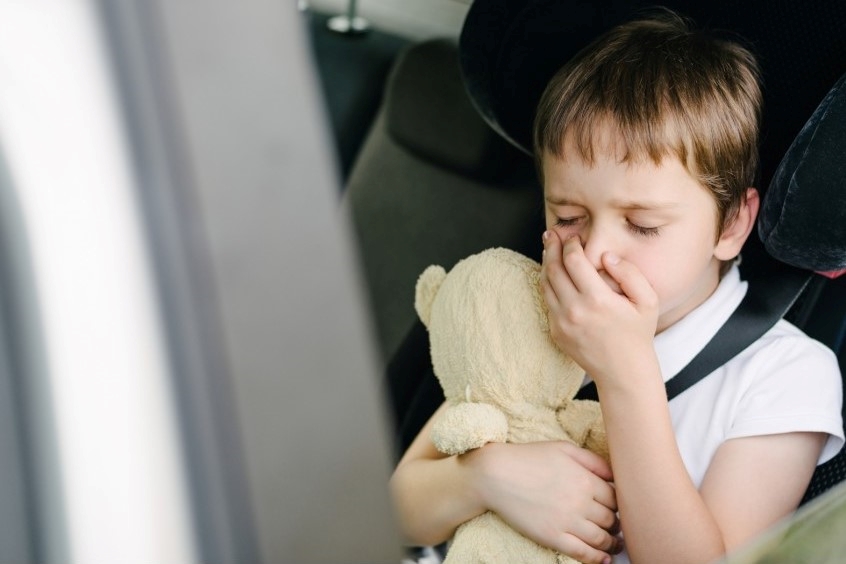
Car sickness, transport in paediatric age: what causes and how to deal with motion sickness
Motion sickness, better known as car sickness, is a disorder suffered by 30% of children, especially between the ages of 3 and 12. How it manifests itself in children and how to prevent it
The causes of car sickness can be different
The most accepted theory is that kinetosis occurs when the body, inner ear and eyes send conflicting signals to the brain, and this can happen when travelling on any means of transport.
CHILD HEALTH: LEARN MORE ABOUT MEDICHILD BY VISITING THE BOOTH AT EMERGENCY EXPO
What is motion sickness, or car sickness?
- A disorder that occurs under conditions of passive movement such as in a car, but can also occur during travel by sea, aeroplane or train.
- Symptoms are paleness, yawning, cold sweating, malaise, nausea followed by vomiting. Often after the vomiting episode the child feels better
- To prevent it, leave when the child is still sleepy, have a small snack before the journey and stop along the way for frequent snacks
- Avoid carbonated drinks, prefer cool drinks such as water and tea
- During the car journey try to distract your child by singing, listening to music. Avoid reading or playing video games.
- Stop every 2-3 hours and let him take a few steps.
- Keep the car cool by opening the windows a little or using air conditioning in moderation.
- Specific medication such as dimenhydrinate half an hour before departure, or chewing gum at the first symptoms.
- Anti-nausea bracelets based on compression of the P6 point just below the wrist can also be used
Causes of car sickness
It is due to a hypersensitivity of the balance centre (labyrinth), located in the inner ear, which, in predisposed children, overstresses the autonomic nervous system.
The disorder tends to occur under all conditions of passive movement and can present as ‘car sickness’, ‘sea sickness’, ‘plane sickness’, ‘train sickness’ but also as a result of rotational movements of the body or head.
Excessive visual stimuli can also cause this disorder, e.g. scrolling sideways causes contradictory stimuli, compared to the body being still, which can alter the vestibular apparatus and give rise to the typical symptoms.
The child may present paleness, yawning, cold sweating, malaise, nausea sometimes followed by vomiting. He often feels better after the vomiting episode.
To prevent motion sickness, a few useful measures can be put into practice:
- Start early when the child is still sleepy;
- Drive quietly without heavy acceleration or deceleration, especially when cornering;
- Avoid strong smells (petrol, perfume, stale air, etc.);
- Give them a small snack before the journey. If the journey is long, make them have frequent snacks of crackers or breadsticks;
- Avoid fizzy drinks, but give him small sips of cool drinks such as water or tea;
- Try to distract him by singing together, listening to music or inviting him to look ahead to recognise the colour of cars or the type of car. Avoid him reading or using video games;
- Keep the environment cool by opening the windows a little or using air conditioning at a temperature of 24°-25°;
- Stop every 2-3 hours and, if it is safe to do so, let him take a few steps;
On longer journeys, with a paediatrician’s prescription, you can use specific medicines such as dimenhydrinate, which can be administered half an hour before departure in the form of soft capsules, and repeated after 4-6 hours in the case of long journeys, or as chewing gum to be used when the first symptoms appear.
An ‘unconventional’ therapy, which, however, often has positive effects on the symptoms of car sickness, is the use of bracelets.
The mechanism of action, based on compression of the P6 point in Chinese medicine, is not completely known, but as they have no side effects, anti-nausea bracelets can also be considered in younger children.
Read Also:
Obstructive Sleep Apnoea: Symptoms And Treatment For Obstructive Sleep Apnoea
Seasickness Or Car Sickness: What Causes Motion Sickness?
Decompression Sickness: What It Is And What It Causes
Obstructive Sleep Apnoea: What It Is And How To Treat It
Grinding Your Teeth While You Sleep: Symptoms And Remedies For Bruxism
Long Covid And Insomnia: ‘Sleep Disturbances And Fatigue After Infection’
Sleep Disorders: The Signs Not To Be Underestimated
Sleepwalking: What It Is, What Symptoms It Has And How To Treat It
What Are The Causes Of Sleepwalking?
Pediatric Obstructive Sleep Apnea
Tiredness And Sleep During The Day: What Can Be The Causes?
Children’s Sleep Guide: How Sleep Has Changed Since The Pandemic


